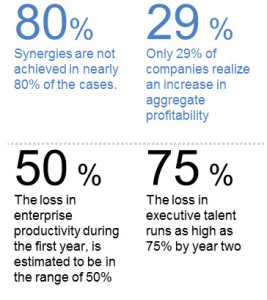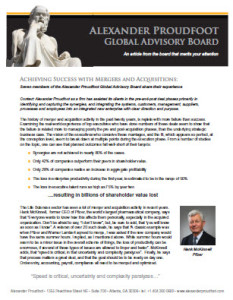 Mergers and acquisitions represent the ultimate challenge for any business -- no other event is more difficult, challenging or chaotic. A bad merger can leave a tarnished legacy where problematic cultural and process issues define the organization.
Mergers and acquisitions represent the ultimate challenge for any business -- no other event is more difficult, challenging or chaotic. A bad merger can leave a tarnished legacy where problematic cultural and process issues define the organization.
Integration needs to be fast
In the words of Pierre Bilger, former CEO of Alstom, "speed is a must" during integration, while uncertainty and complexity can paralyze the entire process.
Post-merger integration requires very quick decision-making. This is partially due to the fact that fast integrations are typically more successful than slower ones. The new organization has to be established quickly so people can perform vital tasks, such as servicing customers and designing products. The more time people spend thinking about the merger, the less likely they will perform at a higher level.
Many decisions will be difficult, such as establishing the new organizational structure, re-assigning personnel, and selling-off assets. However, while the synergy meter is running, it is best to make these decisions as quickly as possible and move on. A delayed response will give the impression of indecisiveness and inability to manage the integration.
In order to make decisions, it is necessary to define roles; people need to know who is in charge. People who are responsible for integration should be highly skilled in coordinating projects, leading people and thinking on their feet while focusing on the strategies behind the merger and acquisition.
People issues
Productivity and performance will usually drop once a merger is announced. The reason is simple: people are concerned about what will happen.
Quick and open communication is essential for managing people issues. Constant communication is required for addressing rumors and questions that will eventually arise. A comprehensive communications approach should reach as many people as possible.
"Get all the facts out. Give people the rationale for change, laying it out in the clearest, most dramatic terms. When everybody gets the same facts, they'll generally come to the same conclusion. When everyone agrees on the current state and resistance is lowered, 'buy-in' to the needed changes is inevitable." - Jack Welch, CEO, General Electric
Managing resistance
The inability to manage resistance is a major reason for failed mergers. Resistance is natural and not necessarily indicative of something wrong. However, it cannot be ignored. Some important tools for managing resistance are:
- Communication: Make sure people know what is going on if you expect to minimize resistance. Rumors should not be the main form of communication. The following quote from a middle-level manager at a meeting with executive management says it all: "How can I tell my people what needs to be done to integrate the two companies when there is a lack of communication throughout the organization."
- Training: People must possess the necessary skills. Investing in people through training can lower the amount of resistance to eventually achieve buy-in.
- Involvement: Resistance can be reduced by including people in the decision-making process. Active engagement can also help identify problem areas.
Closing the cultural gap
One of the biggest challenges is to close the cultural divide between the two companies. Cultural differences should be identified via due diligence. One way of closing the cultural gap is to invent a new corporate culture as opposed to forcing one existing culture into another company.
Retaining key personnel
Mergers often result in the loss of key (essential) personnel. Since synergies are highly dependent upon quality personnel, it will be important to take steps for retaining the high performers.
Determine what motivates essential personnel. Some people are motivated by their work, while others are interested in climbing the corporate ladder. Retention programs are designed around these motivating factors.
